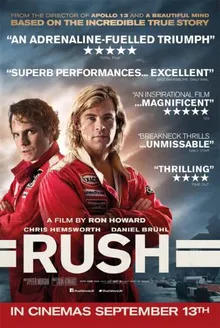Historical accuracy of Rush

Historical accuracy of Rush

Characters
James Hunt
Hemsworth captures Hunt's public persona, lifestyle, and driving flair accurately. His portrayal was called "uncanny" by Hunt's former boss, Lord Hesketh.
Niki Lauda
Brühl's portrayal was highly praised, even by Lauda himself, for capturing his mannerisms, focus, and accent. Lauda felt the film made him seem slightly more serious than he was ("I was half of James").
Suzy Miller
Accurately portrayed as the model Hunt married quickly and who subsequently left him for actor Richard Burton.
Marlene Lauda
Portrayed as supportive, especially during his recovery. Her initial reaction to Lauda's disfigurement was reportedly downplayed in the film compared to reality.
Clay Regazzoni
Accurately depicted as Lauda's experienced teammate at Ferrari during the 1975 and 1976 seasons.
Alastair Caldwell
Represents McLaren's management during Hunt's championship year. Specific conversations or decisions shown might be dramatized for narrative effect.
More characters
Lord Hesketh
Accurately portrays the flamboyant aristocratic character who gave James Hunt his start in Formula 1 with his own team.
Louis Stanley
Represents the leadership at BRM where Lauda drove briefly early in his F1 career (though the film skips his time at March). Portrayed accurately as somewhat pompous.
Enzo Ferrari
Appears briefly, embodying the legendary and demanding figurehead of the Scuderia Ferrari team.
Story
Hunt/Lauda rivalry starting in Formula 3
The film depicts an intense early clash at Crystal Palace; Lauda wasn't at that specific race. While rivals, they were actually friends off-track early on, sharing a flat, which contrasts with the film's initial portrayal.
Depiction of the 1976 F1 Championship season
Accurately follows the main events, dramatic turns, and points battle of the highly competitive 1976 season between Hunt and Lauda.
Hunt's disqualification from Spanish GP
Hunt's McLaren was disqualified for being too wide (later reinstated). The film's implication that Lauda directly caused the check is inaccurate; stringent checks were planned regardless.
Lauda urges boycott of German GP at Nürburgring
Lauda did argue against racing due to safety concerns in the rain at the dangerous Nürburgring. He lost the vote (though by a narrower margin than shown).
Lauda's fiery crash at Nürburgring
The crash sequence (caused by suspension failure) and Lauda's rescue by fellow drivers Arturo Merzario, Brett Lunger, Guy Edwards, and Harald Ertl are depicted with harrowing accuracy.
Lauda's painful recovery and quick return
Lauda confirmed the depiction of his agonizing recovery (burns, lung damage) and remarkable return to racing just six weeks later at Monza was very accurate.
Hunt gains points during Lauda's absence
Hunt significantly closed the championship gap by winning races while Lauda was recovering.
Final race at Fuji decides championship
Accurately shows the extreme rain, Lauda withdrawing due to danger, and Hunt needing 4th or better. Dramatizes Hunt's tire issue/recovery and misidentifies who he passed for the crucial points.
Hunt wins the 1976 World Championship
Hunt finished 3rd at Fuji, securing enough points to win the championship by one point over Lauda.
Hunt punches journalist defending Lauda
This scene was invented for the film to show Hunt's character and respect for Lauda, but it did not happen in reality.
Contrasting personalities and approaches
Effectively highlights the core differences between Hunt's intuitive, high-living style and Lauda's analytical, disciplined approach to racing and life, though Lauda noted he wasn't quite as serious as depicted.
Lauda clinching 1975 title depiction
The film shows Lauda winning the '75 title at Watkins Glen; he actually clinched it at Monza earlier that season.
Hunt's marriage to Suzy Miller / Divorce
Accurately depicts Hunt's whirlwind marriage to Suzy Miller and her subsequent relationship with Richard Burton.
Setting
1970s Formula 1 environment
Captures the era's unique blend of glamour, extreme danger, developing technology, and intense competition. Accurately reflects the high mortality rate among drivers during that period.
Formula 1 cars (McLaren M23, Ferrari 312T2)
Utilized a mix of authentic vintage F1 cars and high-quality replicas, providing a visually accurate representation of the iconic machinery from the 1976 season.
Race track recreations
Used real circuits like Brands Hatch and Nürburgring, combined with other UK tracks cleverly dressed and digitally enhanced to represent various international venues (Fuji, Monza, Kyalami, etc.).
Race sequences and driving realism
Employed skilled stunt drivers and realistic choreography (based on actual driving styles) combined with effective editing and sound design to create convincing and exciting race scenes.
1970s fashion, style, and aesthetics
Costumes, hairstyles, vehicles, and overall production design accurately reflect the look and feel of the mid-1970s.
Pit lane and paddock atmosphere
Recreated the bustling, less formalized environment of 1970s F1 pit lanes and paddocks, including period team transporters.
Depiction of F1 safety standards (lack of)
Clearly shows, especially through Lauda's crash, the significantly lower safety measures (trackside barriers, car construction, fire response) compared to modern Formula 1.
